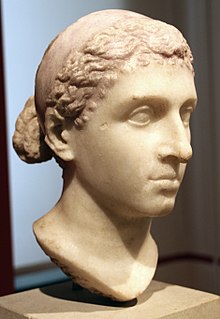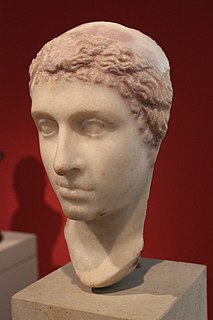 W
WCleopatra VII Philopator was Queen of the Ptolemaic Kingdom of Egypt, and its last active ruler. A member of the Ptolemaic dynasty, she was a descendant of its founder Ptolemy I Soter, a Macedonian Greek general and companion of Alexander the Great. After the death of Cleopatra, Egypt became a province of the Roman Empire, marking the end of the second to last Hellenistic state and the age that had lasted since the reign of Alexander. Her native language was Koine Greek, and she was the only Ptolemaic ruler to learn the Egyptian language.
 W
W216 Kleopatra is a metallic, ham-bone-shaped asteroid and trinary system orbiting in the central region of the asteroid belt, with a mean diameter of 120 kilometers. It was discovered on 10 April 1880, by Austrian astronomer Johann Palisa at the Austrian Naval Pola Observatory, in what is now Pula, Croatia. The M-type asteroid has a shorter than average rotation period of 5.4 hours. It was named after Cleopatra, the famous Egyptian queen. Two small minor-planet moons were discovered in 2008, and later named Alexhelios and Cleoselene.
 W
WThe Battle of Actium was a naval battle fought between a maritime fleet led by Octavian and the combined fleets of both Mark Antony and Cleopatra VII Philopator. The battle took place on 2 September 31 BC in the Ionian Sea, near the former Roman colony of Actium, Greece, and was the climax of over a decade of rivalry between Octavian and Antony.
 W
WAntirhodos was an island in the eastern harbor of Alexandria, Egypt, on which a Ptolemaic Egyptian palace was sited. The island was occupied until the reigns of Septimius Severus and Caracalla and it probably sank in the 4th century, when it succumbed to earthquakes and a tsunami following an earthquake in the eastern Mediterranean near Crete in the year 365. The site now lies underwater, near the seafront of modern Alexandria, at a depth of approximately five metres (16 ft).
 W
WAntony's Parthian War was a military campaign by Mark Antony, the eastern triumvir of the Roman Republic, against the Parthian Empire under Phraates IV.
 W
WArsinoë IV was the fourth of six children and the youngest daughter of Ptolemy XII Auletes. Queen and co-ruler of Ptolemaic Egypt with her brother Ptolemy XIII from 48 BC – 47 BC, she was one of the last members of the Ptolemaic dynasty of ancient Egypt. Arsinoë IV was also the half sister of Cleopatra VII. For her role in conducting the siege of Alexandria against her sister Cleopatra, Arsinoë was taken as a prisoner of war to Rome by the Roman triumvir Julius Caesar following the defeat of Ptolemy XIII in the Battle of the Nile. Arsinoë was then exiled to the Temple of Artemis at Ephesus in Roman Anatolia, but she was executed there by orders of triumvir Mark Antony in 41 BC at the behest of his lover Cleopatra.
 W
W"Asp" is the modern anglicisation of the word "aspis", which in antiquity referred to any one of several venomous snake species found in the Nile region. The specific epithet, aspis, is a Greek word that means "viper". It is believed that aspis referred to what is now known as the Egyptian cobra.
 W
WThe Battle of the Nile in 47 BC saw the combined Roman–Egyptian armies of Julius Caesar and Cleopatra VII defeat those of the rival Queen Arsinoe IV and King Ptolemy XIII and secure the throne of Egypt.
 W
WCaesar's Civil War was one of the last politico-military conflicts in the Roman Republic before the establishment of the Roman Empire. It began as a series of political and military confrontations, between Julius Caesar, his political supporters, and his legions, against the Optimates, the politically conservative and socially traditionalist faction of the Roman Senate, who were supported by Pompey and his legions.
 W
WThe Caesareum of Alexandria is an ancient temple in Alexandria, Egypt. It was conceived by Cleopatra VII of the Ptolemaic kingdom, the last pharaoh of Ancient Egypt, to honour her first known lover Julius Caesar. The edifice was finished by the Roman Emperor Augustus, after he defeated Mark Antony and Cleopatra in Egypt. He destroyed all traces of Antony in Alexandria, and apparently dedicated the temple to his own cult.
 W
WThe race of Cleopatra VII, the last active Hellenistic ruler of the Macedonian-led Ptolemaic Kingdom of Egypt, has caused some debate in scholarly and non-scholarly circles. For example, the article "Was Cleopatra Black?" was published in Ebony magazine in 2012. Mary Lefkowitz, Professor Emerita of Classical Studies at Wellesley College, traces the origins of the Black Cleopatra claim to the 1946 book by J.A. Rogers called "World's Great Men of Color." Lefkowitz refutes Rogers' hypothesis, on various scholarly grounds. The black Cleopatra claim was further revived in an essay by afrocentrist John Henrik Clarke, chair of African history at Hunter College, entitled "African Warrior Queens." Lefkowitz notes the essay includes the claim that Cleopatra described herself as black in the New Testament's Book of Acts – when in fact Cleopatra had died more than sixty years before the death of Jesus Christ.
 W
WThe death of Cleopatra VII, the last ruler of Ptolemaic Egypt, occurred on either 10 or 12 August, 30 BC, in Alexandria, when she was 39 years old. According to popular belief, Cleopatra killed herself by allowing an asp to bite her, but for Greek and Roman historians, Cleopatra poisoned herself using either a toxic ointment or by introducing the poison with a sharp implement such as a hairpin. Primary source accounts are derived mainly from the works of the ancient Roman historians Strabo, Plutarch, and Cassius Dio. Modern scholars debate the validity of ancient reports involving snakebites as the cause of death and if she was murdered or not. Some academics hypothesize that her Roman political rival Octavian forced her to kill herself in a manner of her choosing. The location of Cleopatra's tomb is unknown. It was recorded that Octavian allowed for her and her husband, the Roman politician and general Mark Antony, who stabbed himself with a sword, to be buried together properly.
 W
WThe Donations of Alexandria were a political act by Cleopatra VII and Mark Antony in which they distributed lands held by Rome and Parthia amongst Cleopatra's children, and granted them many titles, especially for Caesarion, son of Julius Caesar. These were the second of two such donations; a similar donations ceremony was held two years earlier in Antioch in 36 BC, at which time the donations enjoyed Octavian's full approval of the Antonian strategy to rule the East making use of Cleopatra's unique royal Seleucid lineage in the regions donated. Ultimately, the Donations caused a fatal breach in Antony's relations with Rome and were amongst the causes of the Final War of the Roman Republic.
 W
WThe early life of Cleopatra VII of Ptolemaic Egypt began with her birth in early 69 BC to reigning pharaoh Ptolemy XII Auletes and her unknown mother, and lasted until her accession to the throne by March 51 BC. During her early childhood, Cleopatra was brought up in the palace of Alexandria in Egypt and received a primarily-Hellenistic Greek education from her tutor, Philostratos. By adulthood she was well-versed in many languages, including Egyptian, Ethiopian, Hebrew, Arabic, Median, Parthian, Latin, and her native Koine Greek.
 W
WGaius Julius Caesar was a Roman general and statesman. A member of the First Triumvirate, Caesar led the Roman armies in the Gallic Wars before defeating Pompey in a civil war and governing the Roman Republic as a dictator from 49 BC until his assassination in 44 BC. He played a critical role in the events that led to the demise of the Roman Republic and the rise of the Roman Empire.
 W
WPtolemy XII Neos Dionysos Philopator Philadelphos was a Pharaoh of the Ptolemaic dynasty of Ancient Egypt. He was commonly known as Auletes, referring to the king's love of playing the flute in Dionysian festivals. As a member of the Ptolemaic dynasty, he was a descendant of its founder, Ptolemy I.
 W
WThe reign of Cleopatra VII of the Ptolemaic Kingdom of Egypt began with the death of her father, the ruling pharaoh Ptolemy XII Auletes, by March 51 BC. It ended with her death on 10 or 12 August 30 BC. Following the reign of Cleopatra, the country of Egypt was transformed into a province of the Roman Empire and the Hellenistic period came to an end. During her reign she ruled Egypt and other territories as an absolute monarch, in the tradition of the Ptolemaic dynasty's founder Ptolemy I Soter as well as Alexander the Great of Macedon, who captured Egypt from the Achaemenid Persian Empire.
 W
WTaposiris Magna is a city established by Pharaoh Ptolemy II Philadelphus between 280 and 270 BCE. The name means "great tomb of Osiris", which Plutarch identifies with an Egyptian temple in the city.
 W
WThe War of Actium was the last civil war of the Roman Republic, fought between Mark Antony and Octavian. In 32 BC, Octavian convinced the Roman Senate to declare war on the Egyptian queen Cleopatra. Her lover and ally Mark Antony, who was Octavian's rival, gave his support for her cause. Forty-percent of the Roman Senate, together with both consuls, left Rome to join the war on Antony's side. After a decisive victory for Octavian at the Battle of Actium, Cleopatra and Antony withdrew to Alexandria, where Octavian besieged the city until both Antony and Cleopatra were forced to commit suicide.